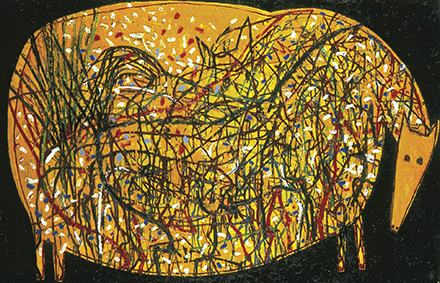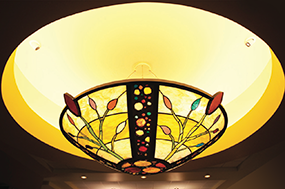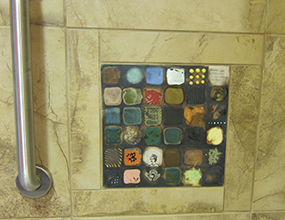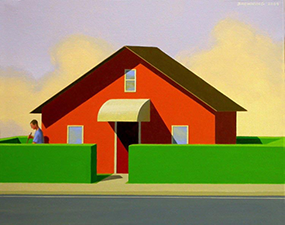Martha Jefferson Hospital, Charlottesville
Words [ Rick Piester ]
 For most people, hospitals can be pretty scary places. As a patient or a patient’s family, you seldom feel in control. Most of the time, you are there because something is wrong. Hospital buildings are big, and many of them are confusing and easy to get lost in. Fluorescent lighting, monochromatic hallways and sterile exam and treatment rooms do not inspire relaxation or comfort.
For most people, hospitals can be pretty scary places. As a patient or a patient’s family, you seldom feel in control. Most of the time, you are there because something is wrong. Hospital buildings are big, and many of them are confusing and easy to get lost in. Fluorescent lighting, monochromatic hallways and sterile exam and treatment rooms do not inspire relaxation or comfort.
Hospitals, though, have been working hard to reverse that image. They have become much more welcoming in recent years by paying attention to all the things that “humanize” a building — colors and surfaces, warmer lighting, less confusing building layout, better signage, and more.
The newly opened Martha Jefferson Hospital in Charlottesville, for example, partnered with Wisconsin-based architectural firm Kahler Slater to design a new 540,000-square- foot hospital building within sight of Thomas Jefferson’s Monticello. Hospital planners and designers incorporated an approach known as evidence-based design, based on a large and growing body of research that demonstrates how the physical environment can impact patient stress, patient and staff safety, the effectiveness of hospital staff, and the quality of care that is provided in a hospital.
 Hospital planners, for example, capitalized on the rolling hills that surround Charlottesville by building the hospital into a hill, rather than on the hill. This preserves the natural environment and prevents the building from appearing overwhelmingly large as patients and visitors arrive. In addition, the surface treatments of the new building are materials familiar to Central Virginians, and large windows bring in natural light and views of the familiar countryside. It’s all designed to put people at ease and help them heal.
Hospital planners, for example, capitalized on the rolling hills that surround Charlottesville by building the hospital into a hill, rather than on the hill. This preserves the natural environment and prevents the building from appearing overwhelmingly large as patients and visitors arrive. In addition, the surface treatments of the new building are materials familiar to Central Virginians, and large windows bring in natural light and views of the familiar countryside. It’s all designed to put people at ease and help them heal.
Important elements of the overall visual appeal of the new building are more than 700 pieces of art, specially selected over a two-year period by a hospital committee intent on finding pieces, largely by Charlottesville area artists, that would essentially become part of the healing environment.
Martha Hunter, Martha Jefferson’s director of outpatient care centers and guest services, was the art committee facilitator. She notes that the display of art throughout the building was incorporated in the early stages of building design. “Instead of adding art as something of an afterthought at the end of the process, we identified the specific spaces where art would be displayed early on,” she says. “That allowed us to provide for appropriate lighting, for the best backing on the walls for the art that would be displayed there, and it helped us avoid conflicts with utility fixtures, way-finding signage, and things of that nature. So art is part of the fabric of the building, part of the architecture.”
 The Martha Jefferson committee was aided in its work by Lillian Fitzgerald, an Alexandria-based Curator who provides consulting services to healthcare organizations, including the National Institutes of Health.
The Martha Jefferson committee was aided in its work by Lillian Fitzgerald, an Alexandria-based Curator who provides consulting services to healthcare organizations, including the National Institutes of Health.
She notes that the committee was delighted to learn that many of the local artists had lifelong
connections to Martha Jefferson Hospital. “Many area artists had been born there,” she says, “they and their families had been patients at the hospital and their babies had been born there. It is a very personal relationship between the artists and the hospital.”
For this reason, many of the artists — including those whose work is followed on a national scale — provided pieces as donations or at reduced fees. Such an artist is Charlottesville-area resident Sam Abell, a leading American photographer and frequent contributor to National Geographic magazine. He provided 13 of his images, that Hunter and Fitzgerald say “changed the collection” —one of which is a photograph of a fountain whose spray suggests a heart shape. It hangs outside a cardiac care waiting area.
 The art is displayed mostly in public areas, examination and treatment rooms, and waiting areas, but individual patients rooms are not overlooked. In fact, the bathroom of each patient room includes a 12″ x 12″ tile created especially for the hospital’s art program.
The art is displayed mostly in public areas, examination and treatment rooms, and waiting areas, but individual patients rooms are not overlooked. In fact, the bathroom of each patient room includes a 12″ x 12″ tile created especially for the hospital’s art program.
“There’s not a more stressful time than when you are in a hospital,” Fitzgerald notes, “but the right kind of art can transport you. It is so much more than a simple distraction; it is the source of healing inspiration, and hope.”
Hospitals that incorporate art into a building’s design find that the work of local artists not only helps create a healing environment, but also makes their facilities a destination for people who love art. And it also honors the artists by showing how their work is a healing force, and a permanent part of the life of the community.
